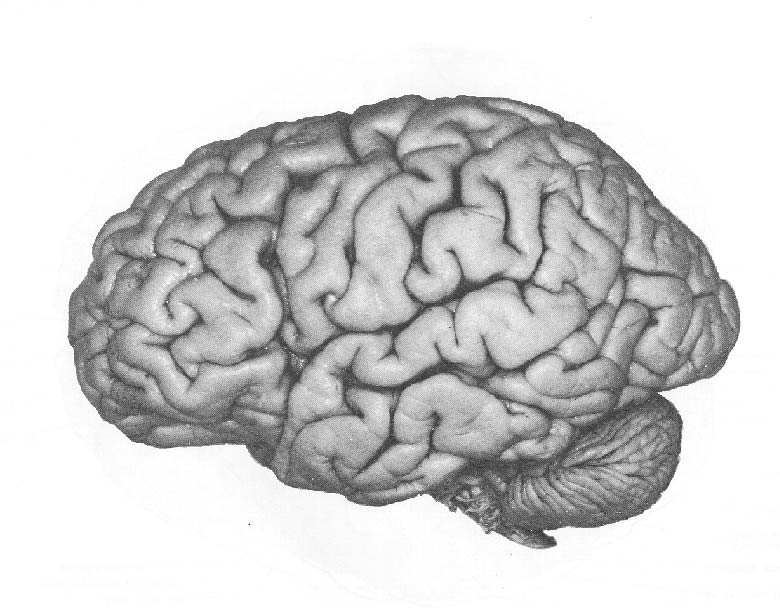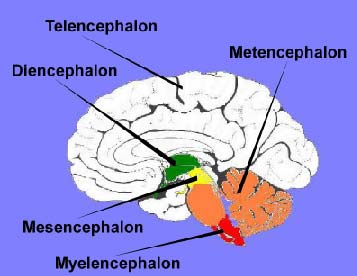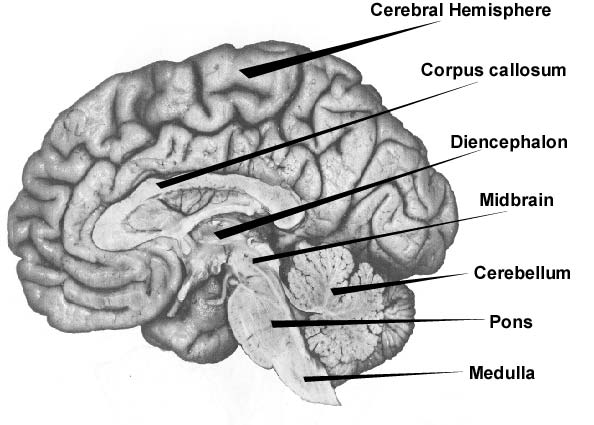


The Central Nervous System consists of the spinal cord and the brain. (The peripheral nervous system consists of neurons elsewhere in the body, motor and sensory, which are connected to the spinal cord.) The brain is that portion of the central nervous system which is located inside the skull. It is commonly divided into five main parts, listed here in order from lowest (adjacent to the spinal cord) to highest (farthest from the spinal cord):

What are all these terms ending in -encephalon? Well, they come from the Greek encephalon, the word for "brain", from and en- "in" and cephalon "head"; so "that which is in the head — the brain". You have no doubt encountered this term as part of electroencephalogram (EEG), "a picture (gram) of electrical activity in the brain" and encephalitis "inflammation of the brain". The order of the 5 layers can be memorized by remembering that the telencephalon is on the top and that the other four divisions are arrayed below it in alphabetical order. More information about any one of the major divisions above can be found by clicking on the link above or on the appropriate spot in the diagram above.
Another way of drawing boundaries divides the brain into three parts, as follows:
2) Midbrain: the mesencephalon
3) Hindbrain: the metencephalon and
myelencephalon
And yet another way of organizing is to recognize a structure called the brain stem, consisting of the midbrain, the pons, and the medulla — that is, the midbrain and the hindbrain except for the cerebellum. Because the brain stem is a pretty cohesive unit, we could also partition the brain as follows:
2) Diencephalon:
thalamus and hypothalamus
3) Cerebellum
4) Brain Stem
Pons
Medulla

Which of these three partitions is correct? Wrong question: They are all correct — just slightly different points of view.
Although all of the structures of the brain interact together, language seems to basically be implemented in the telencephalon (tel-/tele-, "distant, end", the cerebral hemispheres. It's not that the other parts of the brain are not important for language. They are, but it turns out that they are unimportant for the kinds of linguistic phenomena that linguists have traditionally studied, including the kinds discussed here. The sub-cerebral structures, including especially the cerebellum, are actually very important in the extraordinarily complex process of controlling the organs of speech production, but these are details that lie beyond phonology and phonetics as ordinarily studies in linguistics — for better of worse, probably worse. In any case, just about everything said about phonology and phonetics in these pages and other works on linguistics lies in the jurisdiction of the cerebral cortex. It sends out high-level commands, as it were, and the basal ganglia and cerebellum and other subcortical structures translate them into more detailed specifications which they transmit to the muscles, providing the subtle and intricate timing control needed to make tongue and lips and jaw and pharynx and larynx and the muscles of the rib cage and the diaphragm and so forth work in coordinated harmony.
Go to Menu (for non-frame version.)
© 2000 Rice University. This document, or any portion hereof, may be used for non-commercial informational purposes only. Any copy of this document, or portion hereof, must include the copyright notice (http://www.rice.edu/about/cr-notice.html) in its entirety.